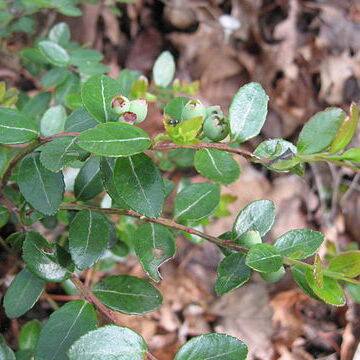Plants 2-4 dm, forming small to extensive colonies; branches spreading or procumbent; twigs of current season pale green to grayish brown, (strongly angled), puberulent. Leaves persistent; petiole 0.5-3 mm; blade pale green abaxially, shiny dark green adaxially, ovate, 1-2.5 × 0.5-1.3 cm, coriaceous, base rounded, margins crenate or serrulate, (revolute), apex obtuse, without resinous dots, surfaces glabrous adaxially, glabrous or puberulent along midvein and near blade base. Inflorescences spreading, 2-5-flowered, sometimes flowers solitary, ebracteate, 0.5-1 cm, puberulent. Pedicels 0.5-3 mm, glabrous; bracteoles (early deciduous), 1-3, (ovate), 2-4 mm, (margins ciliate). Flowers: sepals 4-5, 0.3-0.5 mm, glabrous; petals 4-5, corolla white to pink, campanulate-urceolate, 4 mm, lobes broadly deltate to rounded, 0.5-1.5 mm; filaments 1-1.5 mm, glabrous; anthers included, 1-1.5 mm, thecae not divergent distally; ovary glabrous. Drupes juicy, sweet, light blue, 6-8 mm diam., glabrous. Seeds 1-1.5 mm.
More
Plants not glandular; stems 2–4 dm, bearing a conspicuous ridge below the base of each lf; colonial by long, woody rhizomes; lvs leathery, evergreen, elliptic, 12–22 mm, finely serrulate, glabrous; racemes few-fld, subsessile, shorter than the subtending lvs; cor 5 mm; fr dark blue, edible. Wooded hillsides, chiefly in the mts.; Md. and Del. to Pa., Ky., and e. Tenn.; very local except in W.Va. May, June. (Buxella b.)
A small, spreading evergreen shrub. The branches often root along the ground. They form mounds and are 45 cm high but can spread very widely through the suckers. The leaves are leathery, oval and 25 mm long. They have shallow teeth. The flowers are urn shaped and are white with red tints. They are 6 mm long and hang in long clusters. The fruit are black and 12 mm wide.

